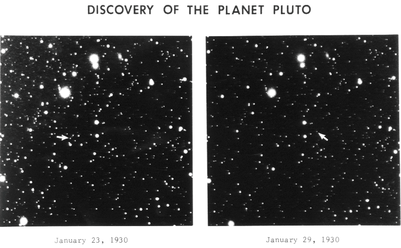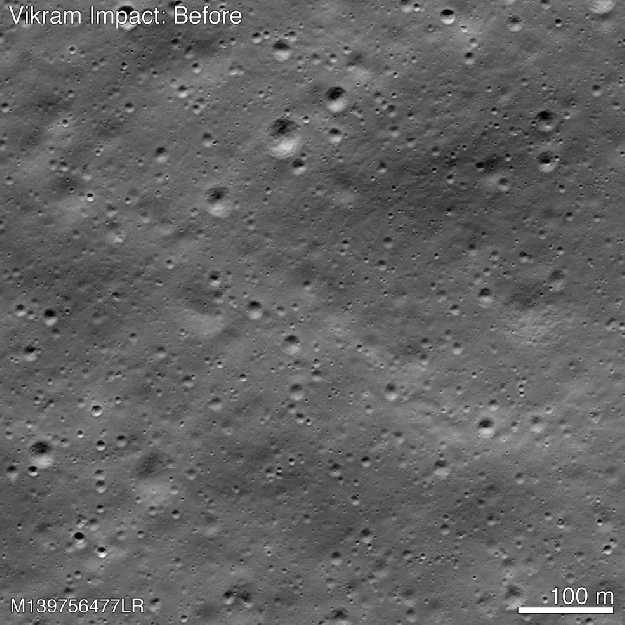What does Pluto — not the dog, but the non-Planet — have in common with the Vikram lunar lander launched by India? Both were found by making very tiny comparisons to photographs. You’d think landing something on the moon would be old hat by now, but it turns out only three countries have managed to do it. The Chandrayaan-2 mission would have made India the fourth country. But two miles above the surface, the craft left its planned trajectory and went radio silent.
India claimed it knew where the lander crashed but never revealed any pictures or actual coordinates. NASA’s Lunar Reconnaissance Orbiter took pictures several times of the landing area but didn’t see the expected scar like the one left by the doomed Israeli lander when it crashed in April. A lot of people started looking at the NASA pictures and one Indian computer programmer and mechanical engineer, Shanmuga Subramanian, seems to have been successful.
According to Shanmuga and NASA, he looked at the last known position and velocity and used it to estimate where there might be debris. A white spec about a kilometer away from the proposed landing site wasn’t there on earlier images of the same area. NASA received the report of the suspected finding and confirmed it along with finding a spray of debris.
Is It or Isn’t It?
According to NASA, the camera resolution is about 1.3 meters per pixel and the largest debris is about two square pixels. The Indian Space Research Organization (ISRO) claims they already knew where the lander crashed. On the other hand, a senior ISRO official has cast doubt on the NASA images, although he points out he is stating his personal views. Still, you’d presume if they know where it is, they would know for sure if the NASA analysis is correct or not.
See For Yourself
NASA has a great before and after image that shows the difference very clearly. You can see it below:
Pluto in a Blink
This couldn’t help but remind me of how Pluto was discovered using a machine called a blink comparator. This machine dates back to 1904 and — like many things — has been superseded by modern technology. In 1930, scientists knew there was something pulling the orbits of the planets but they didn’t know where it was.
The blink comparator helps you find something that moves by showing you two photographic plates in quick succession. Anything in the same spot on both plates appears stationary. Anything moving in the frame will stand out as it appears to jump from one spot to another.
In 1906, Percival Lowell started searching for “Planet X” in earnest. He died ten years later never knowing that he had photographed Pluto twice in 1915 but failed to notice it. Retrospectively, there were at least 14 other photographs of the quasi-planet that no one noticed at the time, going back to 1909.
 In 1929 — after a lot of legal battles between the Lowell Observatory and Lowell’s widow, the search resumed with Clyde Tombaugh given the task as something suitable for a young astronomer. Tombaugh took pictures of the night sky in pairs and used a blink comparator to see if anything moved. He had a 13″ telescope — respectable, but not huge by today’s standards.
In 1929 — after a lot of legal battles between the Lowell Observatory and Lowell’s widow, the search resumed with Clyde Tombaugh given the task as something suitable for a young astronomer. Tombaugh took pictures of the night sky in pairs and used a blink comparator to see if anything moved. He had a 13″ telescope — respectable, but not huge by today’s standards.
The discovery came out in March of 1930. Did you know that since then Pluto still hasn’t made it all the way around the sun? A year on Pluto is nearly 250 Earth years long. You can see more about the comparator at the Lowell Observatory in the video below.
Modern Science
While Tombaugh wasn’t technically a citizen scientist, we have access to tools he couldn’t dream of. While blink comparators are a thing of the past, we have a whole arsenal of digital imaging tools along with large numbers of images from ground-, space-, and vehicle-based telescopes and cameras. We applaud Shanmuga Subramanian for making use of these tools so successfully.
You can even do observations with a crowd if you like. You can also use some pretty big scopes online. Meanwhile, good luck to ISRO with their third mission, coming soon.

No comments:
Post a Comment